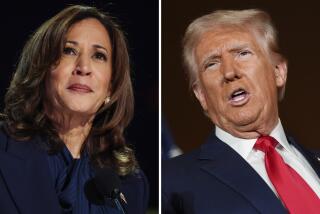Republicans plan to overhaul the tax system. Hereâs what theyâre thinking so far
Congressional Republicans are planning a massive overhaul of the nationâs tax system, a heavy political lift that could ultimately affect families at every income level and businesses of every size.
Their goal is to simplify a complicated tax code that rewards wealthy people with smart accountants, and corporations that can easily shift profits â and jobs â overseas. It wonât be easy. The last time it was done was 30 years ago.
Senate Majority Leader Mitch McConnell (R-Ky.) and Speaker Paul Ryan (R-Wis.) have vowed to pass a tax package in 2017 that would not add to the budget deficit. The Washington term for that is ârevenue neutral.â
It means that for every tax cut there has to be a tax increase, creating winners and losers. Lawmakers would get some leeway if nonpartisan congressional analysts project that a tax cut would increase economic growth, raising revenue without increasing taxes.
Passing a massive tax package will require some politically tough votes.
Some key Republican senators want to share the political risk with Democrats. They argue that a tax overhaul must be bipartisan to be fully embraced by the public. They cite President Obamaâs health law â the Affordable Care Act, which passed in 2010 without any Republican votes â as a major policy initiative that remains divisive.
Congressional Democrats say they are eager to have a say in overhauling the tax code. But McConnell, who faulted Democrats for acting unilaterally on healthcare, is laying the groundwork to pass a purely partisan bill.
Both McConnell and Ryan said they plan to use a legislative maneuver that would prevent Senate Democrats from using the filibuster to block a tax bill.
McConnell says he wants the Senate to tackle a tax plan in the spring, after Congress repeals Obamaâs health law. House Republicans are more eager to get started, but they havenât set a timeline.
Some things to know about Republican efforts to overhaul the tax code:
The House plan
House Republicans have released the outline of a tax plan that would lower the top individual income tax rate to 33% from 39.6% and reduce the number of tax brackets to three from seven. The gist of the plan is to lower tax rates for just about everyone, and to make up the lost revenue by scaling back exemptions, deductions and credits.
The plan, however, retains some of the most popular tax breaks, including those for paying a mortgage, going to college, making charitable contributions and having children.
The standard deduction would be increased, giving taxpayers less incentive to itemize their deductions.
The nonpartisan Tax Policy Center says the plan would reduce revenue by $3 trillion over the first decade, with most of the savings going to the highest-income households. Thatâs not revenue neutral.
Small-business owners would get a special top tax rate of 25%.
Investment income would be taxed like wages, but investors would have to pay taxes on only half of this income.
The Senate plan
Senate Republicans have yet to coalesce around a comprehensive plan or even an outline.
Trumpâs plan
President-elect Donald Trumpâs plan has fewer details. He promises a tax cut for every income level, with more low-income families paying no income tax at all.
The Tax Policy Center says Trumpâs plan would reduce revenue by $9.5 trillion over the first decade, with most of the tax benefits going to the wealthiest taxpayers. Trump has disputed the analysis.
Like the House plan, Trumpâs plan would reduce the top income tax rate for individuals to 33%, reduce the number of tax brackets to three and increase the standard deduction.
Millions more Americans can afford a doctorâs visit under Obamacare, study shows Âť
Trump has embraced two ideas championed by Obama but repeatedly rejected by Republicans over the last eight years: His plan would cap itemized deductions for married couples making more than $200,000 a year. And it would tax carried interest, which are fees charged by investment fund managers, as regular income instead of as capital gains.
Corporate taxes
The top corporate income tax rate in the U.S. is 35%, the highest in the industrialized world. However, the tax is riddled with so many exemptions, deductions and credits that most corporations pay much less.
Both Trump and House Republicans want to lower the rate, and pay for it by scaling back tax breaks.
Trump wants to lower the corporate tax rate to 15%. Ryan says 20% is more realistic, to avoid increasing the budget deficit.
Border adjustment tax
This is one of the most controversial parts of the House Republicansâ tax plan. It is also key to making it work.
Under current law, the United States taxes the profits of U.S.-based companies even if the money is made overseas. However, taxes on foreign income are deferred until a company either reinvests the profits in the U.S. or distributes them to shareholders.
Critics say the system encourages U.S.-based corporations to invest profits overseas or, more dramatically, to shift operations and jobs abroad to avoid U.S. taxes.
House Republicans want to scrap Americaâs worldwide tax system and replace it with a tax that is based on where a firmâs products are consumed rather than where they are produced.
Under the system, American companies that produce and sell their products in the U.S. would pay the new 20% corporate tax rate on profits from these sales. However, if a company exports a product abroad, the profits from that sale would not be taxed by the U.S.
Thereâs more: Foreign companies that import goods to the U.S. would have to pay the tax, increasing the cost of imports.
Exporters love the idea. But importers, including big retailers and consumer electronics firms, say it could lead to steep price increases on consumer goods. The lobbying has already begun.
ALSO
Hereâs what happens on the airplane before you board your flight
U.S. companies want to play Chinaâs game. They just canât win it
Will the Fedâs Janet Yellen âtake away the punch bowlâ after Trump takes office?
More to Read
Inside the business of entertainment
The Wide Shot brings you news, analysis and insights on everything from streaming wars to production â and what it all means for the future.
You may occasionally receive promotional content from the Los Angeles Times.










